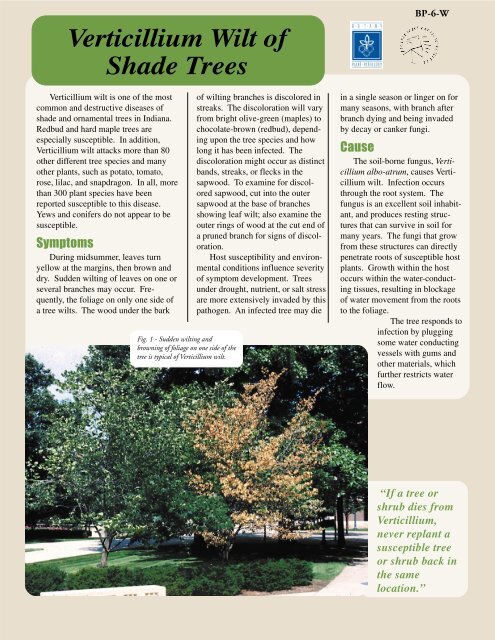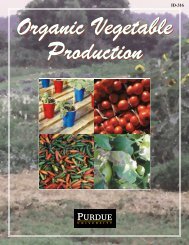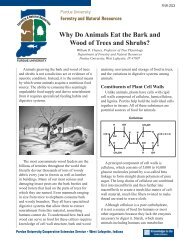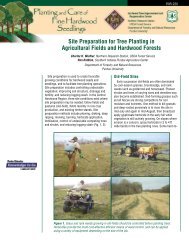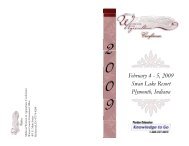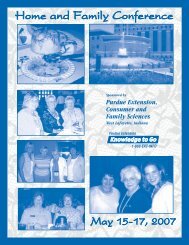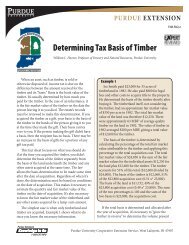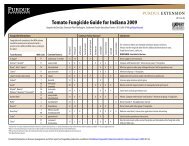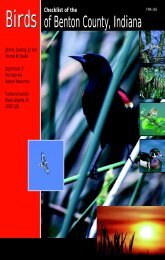Verticillium Wilt of Shade Trees - Purdue Extension - Purdue University
Verticillium Wilt of Shade Trees - Purdue Extension - Purdue University
Verticillium Wilt of Shade Trees - Purdue Extension - Purdue University
You also want an ePaper? Increase the reach of your titles
YUMPU automatically turns print PDFs into web optimized ePapers that Google loves.
<strong>Verticillium</strong> <strong>Wilt</strong> <strong>of</strong><br />
<strong>Shade</strong> <strong>Trees</strong><br />
<strong>Verticillium</strong> wilt is one <strong>of</strong> the most<br />
common and destructive diseases <strong>of</strong><br />
shade and ornamental trees in Indiana.<br />
Redbud and hard maple trees are<br />
especially susceptible. In addition,<br />
<strong>Verticillium</strong> wilt attacks more than 80<br />
other different tree species and many<br />
other plants, such as potato, tomato,<br />
rose, lilac, and snapdragon. In all, more<br />
than 300 plant species have been<br />
reported susceptible to this disease.<br />
Yews and conifers do not appear to be<br />
susceptible.<br />
Symptoms<br />
During midsummer, leaves turn<br />
yellow at the margins, then brown and<br />
dry. Sudden wilting <strong>of</strong> leaves on one or<br />
several branches may occur. Frequently,<br />
the foliage on only one side <strong>of</strong><br />
a tree wilts. The wood under the bark<br />
Fig. 1 - Sudden wilting and<br />
browning <strong>of</strong> foliage on one side <strong>of</strong> the<br />
tree is typical <strong>of</strong> <strong>Verticillium</strong> wilt.<br />
<strong>of</strong> wilting branches is discolored in<br />
streaks. The discoloration will vary<br />
from bright olive-green (maples) to<br />
chocolate-brown (redbud), depending<br />
upon the tree species and how<br />
long it has been infected. The<br />
discoloration might occur as distinct<br />
bands, streaks, or flecks in the<br />
sapwood. To examine for discolored<br />
sapwood, cut into the outer<br />
sapwood at the base <strong>of</strong> branches<br />
showing leaf wilt; also examine the<br />
outer rings <strong>of</strong> wood at the cut end <strong>of</strong><br />
a pruned branch for signs <strong>of</strong> discoloration.<br />
Host susceptibility and environmental<br />
conditions influence severity<br />
<strong>of</strong> symptom development. <strong>Trees</strong><br />
under drought, nutrient, or salt stress<br />
are more extensively invaded by this<br />
pathogen. An infected tree may die<br />
BP-6-W<br />
in a single season or linger on for<br />
many seasons, with branch after<br />
branch dying and being invaded<br />
by decay or canker fungi.<br />
Cause<br />
The soil-borne fungus, <strong>Verticillium</strong><br />
albo-atrum, causes <strong>Verticillium</strong><br />
wilt. Infection occurs<br />
through the root system. The<br />
fungus is an excellent soil inhabitant,<br />
and produces resting structures<br />
that can survive in soil for<br />
many years. The fungi that grow<br />
from these structures can directly<br />
penetrate roots <strong>of</strong> susceptible host<br />
plants. Growth within the host<br />
occurs within the water-conducting<br />
tissues, resulting in blockage<br />
<strong>of</strong> water movement from the roots<br />
to the foliage.<br />
The tree responds to<br />
infection by plugging<br />
some water conducting<br />
vessels with gums and<br />
other materials, which<br />
further restricts water<br />
flow.<br />
“If a tree or<br />
shrub dies from<br />
<strong>Verticillium</strong>,<br />
never replant a<br />
susceptible tree<br />
or shrub back in<br />
the same<br />
location.”
Fig. 2 - Cross-sections <strong>of</strong> Redbud stems<br />
infected with verticillium show brown<br />
solid bands in individual wood rings.<br />
Management<br />
Do not replant susceptible species<br />
where <strong>Verticillium</strong> killed a susceptible<br />
host plant. If <strong>Verticillium</strong> wilt<br />
has been diagnosed in a landscape<br />
site, it is best to replant with a<br />
resistant plant since the soil can be<br />
contaminated with the <strong>Verticillium</strong><br />
fungus for a long time. Replanting<br />
maples or other susceptible plants in<br />
areas where wilt has destroyed<br />
previous trees is inviting recurrence<br />
<strong>of</strong> the trouble. NOTE: Yews and<br />
conifers are resistant to <strong>Verticillium</strong><br />
wilt. Redbud and smoke tree are<br />
especially susceptible. Refer to<br />
tables for a listing <strong>of</strong> resistant and<br />
susceptible trees and shrubs.<br />
When a tree or shrub exhibits<br />
mild symptoms, don’t be too quick to<br />
remove the plant. Prune out affected<br />
limbs and water and fertilize to<br />
maintain tree vigor. In some cases<br />
these tactics may delay progression<br />
<strong>of</strong> the disease for a number <strong>of</strong> years;<br />
however, infection is not cured since<br />
the disease originates in the roots.<br />
<strong>Verticillium</strong> wilt resistant woody plants<br />
Apple Holly Pear<br />
Beech Honey locust Poplar<br />
Birch Hornbeam Pine<br />
Crabapple Juniper Rhododendron<br />
Dogwood Katsura tree Spruce<br />
Fir Larch Sweet gum<br />
Firethorn Linden Sycamore<br />
Ginkgo Mountain ash Walnut<br />
Hackberry Mulberry Willow<br />
Hawthorn Oak Yew<br />
Hickory Pawpaw Zelkova<br />
<strong>Verticillium</strong> wilt susceptible woody plants<br />
Ash Elm Rose<br />
Azalea Golden rain tree Russian olive<br />
Barberry Honeysuckle Sassafras<br />
Boxwood Horse chestnut Serviceberry<br />
Brambles Japanese pagoda tree Smoke tree<br />
Buckeye Lilac Sumac<br />
Black gum Kentucky c<strong>of</strong>fee tree Tree-<strong>of</strong>-heaven<br />
Black locust Magnolia Tulip tree<br />
Box elder Maple Tupelo<br />
Catalpa Osage orange Viburnum<br />
Cherry & other Prunus Persimmon Weigela<br />
Cork tree Privet Yellow wood<br />
Currant Redbud<br />
Fig. 3 - Redbud trees infected with<br />
<strong>Verticillium</strong> will have chocolate-brown<br />
streaking in the sapwood.
The first and most important step<br />
before managing a tree disease is to<br />
accurately diagnose the problem.<br />
With an inaccurate diagnosis, more<br />
harm than good could be done, not<br />
to mention the wasting <strong>of</strong> both time<br />
and money.<br />
This publication is just one <strong>of</strong><br />
several available online from<br />
<strong>Purdue</strong> <strong>Extension</strong> that addresses<br />
diseases found on landscape trees in<br />
Indiana. If your tree does not have<br />
symptoms similar to those described<br />
in this publication, please<br />
check the others.<br />
Also, for more detailed photographs<br />
<strong>of</strong> disease symptoms,<br />
consider purchasing Common Tree<br />
Diseases <strong>of</strong> Indiana (BP-63). It<br />
presents information about the six<br />
most common tree diseases seen in<br />
Indiana. It is available from the<br />
<strong>Purdue</strong> <strong>Extension</strong> Media Distribution<br />
Center. The publication is $5<br />
and can be ordered by calling 1<br />
888-EXT-INFO.<br />
If you are still in doubt as to the<br />
cause <strong>of</strong> the problem, consult a<br />
pr<strong>of</strong>essional such as the <strong>Extension</strong><br />
Educators at your local <strong>Purdue</strong><br />
<strong>University</strong> Cooperative <strong>Extension</strong><br />
Service <strong>of</strong>fice or <strong>Purdue</strong> <strong>University</strong>’s<br />
Plant Pest and Diagnostic Laboratory<br />
(P&PDL).<br />
To submit a plant sample to the<br />
P&PDL for diagnosis, obtain a sample<br />
submission form from your local<br />
<strong>Purdue</strong> <strong>Extension</strong> <strong>of</strong>fice, from the<br />
P&PDL <strong>of</strong>fice (1-888-EXT-INFO), or<br />
from the P&PDL Web page<br />
www.ppdl.purdue.edu/. Detailed<br />
instructions for submitting most types<br />
<strong>of</strong> samples are included on the back <strong>of</strong><br />
the forms.<br />
Submit a sample that is representative<br />
<strong>of</strong> the problem and shows the<br />
varying degrees <strong>of</strong> symptoms. Send<br />
several branches (even large ones)<br />
showing the symptoms and a detailed<br />
description <strong>of</strong> the problem and other<br />
useful information about the site, the<br />
age <strong>of</strong> the tree or shrub, and the date<br />
<strong>of</strong> planting. Photographs are very<br />
helpful.<br />
Send the sample and submission<br />
form by first-class or overnight<br />
mail early in the week to:<br />
Plant & Pest Diagnostic Laboratory<br />
<strong>Purdue</strong> <strong>University</strong><br />
1155 LSPS<br />
West Lafayette, IN 47907-1155<br />
REVISED 3/02<br />
It is the policy <strong>of</strong> the <strong>Purdue</strong> <strong>University</strong> Cooperative <strong>Extension</strong> Service, David C. Petritz, Director, that all persons shall have equal opportunity and<br />
access to the programs and facilities without regard to race, color, sex, religion, national origin, age, marital status, parental status, sexual orientation,<br />
or disability. <strong>Purdue</strong> <strong>University</strong> is an Affirmative Action employer.<br />
This material may be available in alternative formats.<br />
1-888-EXT-INFO


